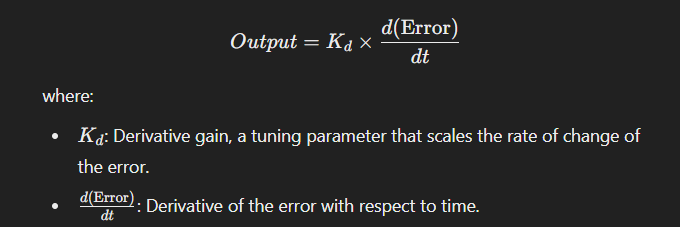. Introduction
- Definition: A Derivative (D) Controller is a type of feedback controller that uses the rate of change of the error to predict future errors and make corrective actions. It responds to how quickly or slowly the error is changing, aiming to reduce oscillations and improve stability in control systems.
- Importance: The D Controller provides an anticipatory effect in the system, which can be essential for applications where preventing overshoot or oscillations is critical.
2. Working Principle
- Rate of Change of Error: The D Controller calculates the derivative of the error, i.e., how fast the error is changing over time. This rate of change is then multiplied by a constant, known as the derivative gain (Kd), to produce the controller output.
- Control Equation:

- Adjustment Mechanism: By predicting the trend of error changes, the D Controller can counteract rapid fluctuations, helping to stabilize the system’s output. The derivative control is particularly helpful in slowing down the response as the error approaches zero, reducing overshoot.
3. Advantages and Disadvantages of D Controller
- Advantages:
- Helps reduce overshoot and oscillations, making the response smoother.
- Improves system stability by providing a damping effect.
- Useful in processes requiring precise control and fast response without overshooting.
- Disadvantages:
- Sensitive to noise, as noise in the system can cause sudden changes in the error’s derivative.
- Not effective if used alone because it doesn’t directly address steady-state error.
- Can make the system too slow if tuned improperly.
4. Applications of D Controller
- Temperature Control in Sensitive Environments: Preventing overshoot in temperature control for processes that are highly sensitive to temperature changes.
- Positioning Systems: In systems like robotic arms or CNC machines, D Controllers help dampen movements to avoid overshoot and achieve precise positioning.
- Motor Speed Control: Managing the speed of motors, especially when frequent speed changes can cause oscillations or instability.
5. Example of D Controller: Robotic Arm Position Control
- Objective: Precisely control the position of a robotic arm and prevent it from overshooting its target position.
- Setup:
- Sensor: Measures the current angle or position of the robotic arm.
- Controller (D): Adjusts the motor’s power to dampen the movement as the arm approaches the setpoint.
- Implementation:
- Measure the current position of the arm and calculate the error from the setpoint.
- Determine the rate of change of this error over time.
- Multiply this rate of change by Kd to get the control output.
- Adjust the motor input based on the output to smooth the approach to the target position, reducing overshoot.
- Expected Outcome: The D Controller will help the arm move smoothly toward the setpoint without significant oscillations or overshoot.
6. Conclusion
- The Derivative (D) Controller is valuable for improving system stability and reducing oscillations, making it especially useful in systems requiring smooth control. However, because it doesn’t address steady-state error directly, it is often combined with other types of controllers, such as Proportional or Integral controllers, to form PID or PD Controllers.